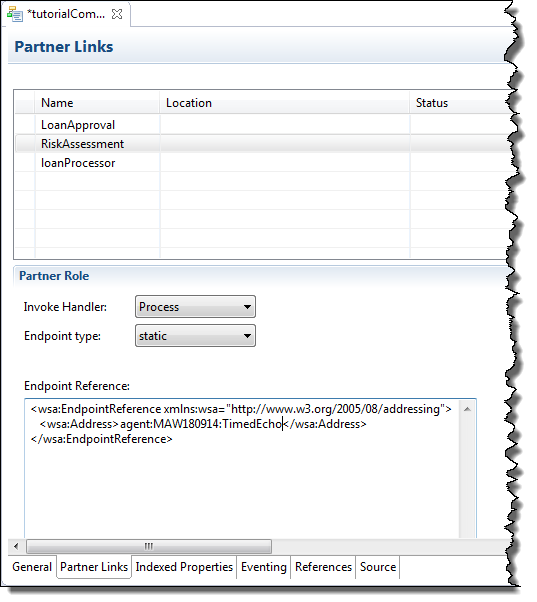Endpoint Reference Addressing Considerations
Process Server supports a variety of addressing options to specify how, when, and where to reach the Web services invoked in a BPEL process. During the creation of the process deployment descriptor (PDD) file, you can add many address details.
Endpoint References and WS-Addressing Considerations
At deployment time, you need to specify the location information for each partner link endpoint reference. Also, you can assign an endpoint reference dynamically, detailed in the Copy Operation Dynamic Endpoint Reference Example.
One of the main protocols to specify location information for an endpoint reference is based on the Web Services Addressing (WS-Addressing) specification.
The WS-Addressing specification standardizes the format for referencing a Web service allowing you to create uniquely identified Web services and Web service instances that are not bound to a specific transport mechanism, such as HTTP. Using WS-Addressing, the endpoint information is added to the header of a SOAP request and not to the URL specified in the SOAP body.
Having endpoint reference information in a SOAP header means that you can do the following:
- •Specify Web service instance IDs
- •Select Reply To and Fault To addressees
- •Select From endpoint references in the case where an acknowledgement needs to be sent back to the sender
Note that in Process Server, you can specify other mechanisms besides SOAP over HTTP. For details, see Custom Service Interactions.
The basic WS-Addressing syntax is as follows:
<wsa:EndpointReference>
<wsa:Address>anyURI</wsa:Address>
<wsa:ServiceName PortName="portname">Service QName
</wsa:ServiceName>
</wsa:EndpointReference>
where:
- •Address is a mandatory element that identifies an endpoint. It can be a network address or a logical address.
- •ServiceName is the qualified name, or QName, for the service being invoked. This service must be defined in a WSDL file that is deployed with the process or one that is available in Process Server's resource catalog.
- •PortName identifies the service port being invoked. Note that you can specify a port binding of SOAP 1.1 or SOAP 1.2.
You can add credential details to the endpoint reference, described in Endpoint References Requiring Credentials for Access.
Note: For information on setting and endpoint reference when deploying to Informatica Cloud, see .
The following versions of the WS-Addressing specification are supported:
- •http://www.w3.org/2005/08/addressing
This is the default version that the PDD uses. For changing the default, see Process Developer Preferences.
- •http://schemas.xmlsoap.org/ws/2004/03/addressing
- •http://schemas.xmlsoap.org/ws/2004/08/addressing
- •http://schemas.xmlsoap.org/ws/2003/03/addressing
You can review the WS-Addressing specification at http://www.w3.org/2005/08/addressing/.
Endpoint References and Informatica Cloud
When deploying a process to Informatica Cloud and the process will be accessed using an agent, you must set fields in the Partner Links tab of the PDD as follows:
Endpoint References Requiring Credentials for Access
At deployment time, you must specify the location information for each partner link endpoint reference. If a partner's service requires authentication for access, you can add credential details to the partner link definition in the process deployment descriptor file. For details, see
Adding Policy Assertions.
Specifying a Replaceable URN URL for an Endpoint Reference
You can specify a logical or physical address for a static endpoint reference in the PDD file. If you specify a logical address, or URN, you can then map the URN to the physical address in the URN Mappings page of the Process Console. If you specify a URL for the static endpoint address, you can replace the URL by mapping it to a different URL on the server.
For example, in the PDD editor, you can specify the following address:
<wsa:Address>urn:localhost:AssessRisk</wsa:Address>
In the Process Console, after you deploy the process, you can map the URN to a URL as follows:
urn:localhost:AssessRisk = http://localhost:8080/active-bpel/services/AssessRisk
For more examples of URN syntax, see the URN Mappings topic in the Process Console Help.
Endpoint References and WS-Policy
The Process Server supports the Web Services Policy Framework (WS-Policy). A policy can describe a broad range of service requirements, preferences, and capabilities. You can add policy information to the endpoint reference section of a process deployment descriptor file. For details, see Adding Policy Assertions.
